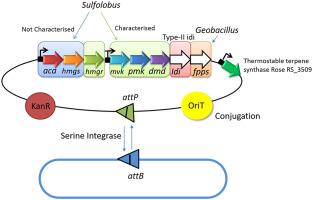Metabolic Engineering ( IF 8.4 ) Pub Date : 2020-11-13 , DOI: 10.1016/j.ymben.2020.11.005 Matthew Q Styles 1 , Edward A Nesbitt 1 , Timothy D Hoffmann 1 , Junichi Queen 1 , Maria V Ortenzi 1 , David J Leak 1

|
Parageobacillus thermoglucosidasius is a genetically tractable thermophile that grows rapidly at elevated temperatures, with a doubling time at 65 °C comparable to the shortest doubling times of Escherichia coli. It is capable of using a wide variety of substrates, including carbohydrate oligomers, and has been developed for the industrial production of ethanol. In this study, P. thermoglucosidasius NCIMB11955 has been engineered to produce the sesquiterpene τ-muurolol by introduction of a heterologous mevalonate pathway constructed using genes from several thermophilic archaea together with a recently characterised thermostable τ-muurolol synthase. P. thermoglucosidasius naturally uses the methylerythritol phosphate pathway for production of the terpene precursor, isopentenyl pyrophosphate, while archaea use a version of the mevalonate pathway. By introducing the orthogonal archaeal pathway it was possible to increase the flux through to sesquiterpene biosynthesis. Construction of such a large metabolic pathway created problems with genetic vector introduction and stability, so recombinant plasmids were introduced by conjugation, and a thermostable serine integrase system was developed for integration of large pathways onto the chromosome. Finally, by making the heterologous pathway maltose-inducible we demonstrate that the new strain is capable of using waste bread directly as an autoinduction carbon source for the production of terpenes in a consolidated bioprocess.
中文翻译:

嗜热副杆菌在使用废面包的综合生物过程中异源生产萜烯
Parageobacillus thermoglucosidasius是一种遗传易处理的嗜热菌,在升高的温度下生长迅速,在 65 °C 下的倍增时间与大肠杆菌最短的倍增时间相当。它能够使用多种底物,包括碳水化合物低聚物,并且已被开发用于乙醇的工业生产。在这项研究中,P. thermoglucosidasius NCIMB11955 通过引入使用来自几种嗜热古细菌的基因以及最近表征的热稳定 τ-muurolol 合酶构建的异源甲羟戊酸途径,被设计为生产倍半萜 τ-muurolol。嗜热葡萄球菌自然地使用甲基赤藓糖醇磷酸途径生产萜烯前体异戊烯焦磷酸,而古细菌使用甲羟戊酸途径的一种形式。通过引入正交古菌途径,可以增加倍半萜生物合成的通量。构建如此大的代谢途径给基因载体引入和稳定性带来了问题,因此通过接合引入重组质粒,并开发了热稳定的丝氨酸整合酶系统以将大途径整合到染色体上。最后,通过使异源途径麦芽糖可诱导,我们证明了新菌株能够直接使用废弃面包作为在综合生物过程中生产萜烯的自诱导碳源。


























 京公网安备 11010802027423号
京公网安备 11010802027423号